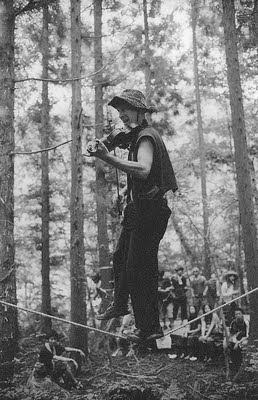Mutō Dori 無刀捕: Hidden Strategy is Beautiful
From Bujinkan Santa Monica by Bujinkan Santa Monica
 |
| Hiding Dog - Sapporo, Japan. photo by MJ/TR (´・ω・) |
Hatsumi Sensei makes reference to this strategy not just when he is unarmed facing a sword wielding attacker, but also during unarmed taijutsu, and while using all manner of weapons.
So forget the sword for a moment, and let's discover some hidden layers in Mutō Dori.
First, relying on any weapon or technique is a trap. If you become an expert, your mind will get stuck there. Use your weapons or techniques with the same mindset as mutō dori. This is a natural, everyday mind.
In avoiding a sword, if you think about avoiding, you will be cut. If you think about not avoiding, you get cut. You should think about nothing and when the sword cuts, naturally get out of the way. Wherever your mind stops is a trap.
Second, don't try to take your opponent's weapon or defeat him. Use 虚実 kyojitsu. If he responds to the 虚 kyo (illusion), give him the 術 jutsu (true form). Or if he has decided not to be fooled by your misdirection, and his mind stops there, determined not to be faked out, the kyo becomes real. It becomes the jitsu. You win by not attaching to either.
Third, Don't let your own weapon or technique be taken. Don't get cut. Makes sense at a basic level- of course you don't want to get cut. But this only occurs when you know the mind or intentions of the opponent.
Hatsumi Sensei says that he was told this by Takamatsu:
"In the instant that the opponent creates a Kiai, you need to avoid the attack."This is not when you hear or notice the Kiai, but the instant it is created. You must be open and connected enough to the spirit of the opponent to recognize that moment when his mind or intent has shifted (or he has decided) to attack.
So to explain these three strategies in a slightly different way,
You must handle weapons freely, yours or his, no matter what kind of weapon and without being attached.
Understand and master the mindset of mutō dori. Not only in your own mind, but the opponent's mind also.
Be able to win without using a weapon.
Make a connection in the kukan without being cut (or cutting the opponent).
Wait, WUT? a connection to what? That is a whole other topic, one that I am just starting to explore in my own training, but don't know how to share yet. Sensei has been talking about these connections a lot the past few years.
Hatsumi Sensei quotes Zeami,
"秘すれば花 Hisureba Hana" (That which is hidden is beautiful)When I glimpse that in training… or I am lucky enough to experience it myself, I definitely find it beautiful.
and then Soke goes on to say,
"Those that live within kyojitsu and uncommon sense (秘常識 hijoshiki) possess a hidden sense."




